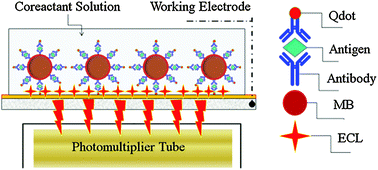Electrogenerated chemiluminescence determination of C-reactive protein with carboxyl CdSe/ZnS core/shell quantum dots†
Abstract

- This article is part of the themed collection: Bioelectrochemistry
* Corresponding authors
a
Department of Chemistry and Biochemistry, The University of Southern Mississippi, Hattiesburg, USA
E-mail:
wujian.miao@usm.edu
Fax: +1-601-266 6075
Tel: +1-601-266 4716
b Visiting scholars from School of Chemistry and Chemical Engineering, Nantong University, Nantong, P. R. China

 Please wait while we load your content...
Something went wrong. Try again?
Please wait while we load your content...
Something went wrong. Try again?
S. Wang, E. Harris, J. Shi, A. Chen, S. Parajuli, X. Jing and W. Miao, Phys. Chem. Chem. Phys., 2010, 12, 10073 DOI: 10.1039/C0CP00545B
To request permission to reproduce material from this article, please go to the Copyright Clearance Center request page.
If you are an author contributing to an RSC publication, you do not need to request permission provided correct acknowledgement is given.
If you are the author of this article, you do not need to request permission to reproduce figures and diagrams provided correct acknowledgement is given. If you want to reproduce the whole article in a third-party publication (excluding your thesis/dissertation for which permission is not required) please go to the Copyright Clearance Center request page.
Read more about how to correctly acknowledge RSC content.
 Fetching data from CrossRef.
Fetching data from CrossRef.
This may take some time to load.
Loading related content
